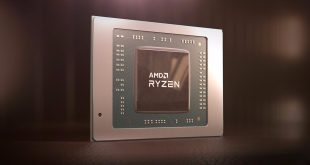Advanced Micro Devices on Thursday unveiled a rather bold strategy called 25X20 under which it intends to dramatically increase energy efficiency of its accelerated processing units by the year 2020. In the next six years AMD plans to further optimize power consumption of its chips and also increase their performance, which is projected to result in 25 times higher energy efficiency by 2020.
“Through APU architectural enhancements and intelligent power efficient techniques, our customers can expect to see us dramatically improve the energy efficiency of our processors during the next several years,” said Mark Papermaster, chief technology officer at AMD, during a keynote at the China International Software and Information Service Fair (CISIS) conference in Dalian, China. “Setting a goal to improve the energy efficiency of our processors 25 times by 2020 is a measure of our commitment and confidence in our approach.”
Moore’s Law states that the number of transistors capable of being built in a given area doubles roughly every two years. According to a research by Jonathan Koomey from Stanford University, energy efficiency of processors has closely tracked the rate of improvement predicted by Moore’s Law, which is logical since newer processors usually deliver higher performance while reducing power consumption compared to predecessors. AMD hopes that four fundamental things will help it to outpace the historical efficiency trend predicted by Moore’s Law (by Dr. Koomey’s derivative from the law, to be precise) by at least 70 per cent between 2014 and 2020.
The four important elements of AMD 25X20 plan are:
- Intelligent power management – various methods of power management have been implemented into chips over the years, so AMD will just continue to refine them in the future. AMD says that going forward, many differentiating capabilities such as inter-frame power gating, per-part adaptive voltage, voltage islands, further integration of system components, and other techniques still in the development stage should yield accelerated gains.
- Architectural advances – the less time it takes to get the job done, the more time a chip spends in in idle mode. Therefore, the better AMD’s x86, ARM and graphics architectures are, the more power-efficient they get thanks to the fact that they can do more job while consuming less amount of power than their predecessors.
- Popularization of the heterogeneous computing – graphics processing units and special-purpose accelerators can perform many tasks better and more efficiently than general-purpose x86 or ARM cores. Therefore, the more programs take advantage of the heterogeneous computing technologies, the more energy efficient the PC becomes.
- New process technologies – a traditional way to reduce power consumption of a circuit is to make using thinner process technologies. AMD expects that 14nm/16nm, 10nm and 7nm process technologies will help it to further decrease power consumption of its products by 2020.
Industry analyst firm Tirias Research recently studied AMD’s methodology for evaluating its energy efficiency and the plans to achieve a 25x improvement by 2020 and produced a publicly-available white paper detailing their analysis.
“The goal of an energy-efficient processor is to deliver more performance than the prior generation at the same or less power,” said Kevin Krewell, analyst at Tirias Research. “AMD’s plan to accelerate the energy-efficiency gains for its mobile-computing processors is impressive. We believe that AMD will achieve its energy efficiency goal, partially through process improvement but mostly by combining the savings from reducing idle power, the performance boost of heterogeneous system architecture, and through more intelligent power management. With this undertaking, AMD demonstrates leadership in the computing industry, driving innovations for a more energy-efficient future.”
Discuss on our Facebook page, HERE.
KitGuru Says: With its new 25X20 message to the world AMD wants to say that going forward it would accelerate improvements of its products faster than it has done before. Since in order to increase power efficiency it is necessary to boost performance in addition to implementation of various other methods, expect the chip designer to actually focus on performance in the future. Let’s just hope that AMD will succeed with its plan.
 KitGuru KitGuru.net – Tech News | Hardware News | Hardware Reviews | IOS | Mobile | Gaming | Graphics Cards
KitGuru KitGuru.net – Tech News | Hardware News | Hardware Reviews | IOS | Mobile | Gaming | Graphics Cards



